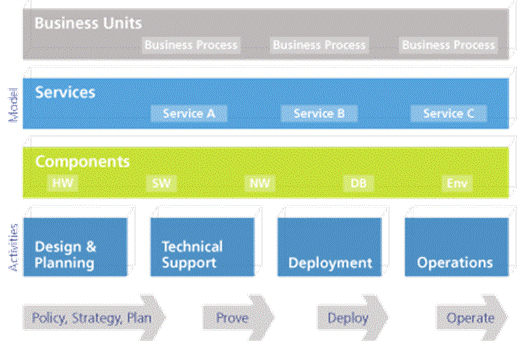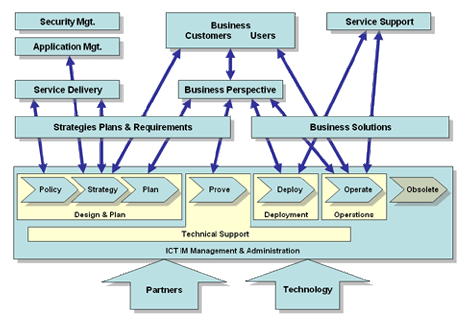One common complaint about ITIL is that it does not address Infrastructure Management or detailed operations – ITIL is descriptive not prescriptive. Another little known ITIL book addresses exactly these areas of concern. |
||||||||||||
By Mike Drapeau Many organizations are adopting IT Service Management (ITSM) and other principles found in the IT Infrastructure Library® (ITIL®) framework to drive improvements to operations.
One common complaint about ITIL is that it does not address Infrastructure Management or detailed operations – ITIL is descriptive not prescriptive.
Much has been written about the ten ITIL processes, how they can be used, what tools, and in what order. What is not often clear to those implementing ITIL that the borderline between ITSM and these disciplines is not clear.
In ITIL parlance, the library which describes all the key activities supporting Infrastructure and Operations is known as the Information and Communications Technology Infrastructure Management (ICT-IM).
The long label betrays the fact that this set of processes is detailed and extensive. In fact, ICT-IM covers the complete set of tasks and day-to-day operational responsibilities that support the ITSM processes.
Without ITIL ICT-IM there can be no Change Management, no Configuration Management and so on, as there would be no components for which to manage change.
In the following article we will examine ITIL’s ICT-IM and its various processes.
The ICT-IM Processes Specifically ICT-IM addresses the lifecycle of system management by break in into four “mega” processes as follows, each of which encompasses a wide swath of people, daily tasking, reporting, and budget:
In order to better understand ICT-IM
first and briefly consider its constituent processes.
Figure 1. ICT-IM Infrastructure Management Processes
Design and Planning This process alone captures all the activity around planning and strategizing around all technology, architectures (e.g. SOA, SEI, etc.), technical documentation, management methods and systems. It has interfaces to the ITIL libraries for Applications Management, ITSM, and The Business. ICT-IM teams integrate with business architects to devise a set of IT standards, procedures, and workflows that satisfy current and future requirements. This work spans the lifecycle of research, selection, introduction, maintenance and retirement of IT infrastructure components. Deployment processes are then used to introduce new technology into Production environments. All of this and Design and Planning is just one of the four key ICT-IM processes.
Deployment Deployment processes govern the introduction of hardware and software changes into the operating environment, guiding activities in all operating environments. It is tempting to confuse Deployment with the more well known Release Management → Change Management processes. Deployment is a far more comprehensive process as it encompasses the long-range planning, budgeting, vendor engagement, line of business or customer interface, enterprise program management, procurement, and actual introduction. Release Management and Change Management, alternatively, are focused on the more narrow objectives of testing a specific Release and then introducing a specific Change into a given environment. They are more ‘transactional’ processes while Deployment covers the strategic spectrum.
Operations Operations is truly the heart of ICT-IM as it includes the day-to-day work required to monitor and maintain a stable IT infrastructure. Some of the tasks associated with the processes are job scheduling, data management (including backup and recovery management), enterprise command center (e.g. NOC), component monitoring, automation, physical database administration and proactive hardware maintenance.
Technical Support The entire set of personnel, practice, and formal policies around knowledge acquisition and distribution underpin the Technical Support process. All architects, technical specialists, and Operations firefighters work in this discipline. They assist Design and Planning by providing technical evaluations, and do the leading edge technology analysis for all future state projects. They also assist technology acquisitions by providing detailed configuration and specification information. Finally, Technical Support acts as a liaison with vendors on all technical matters.
Not Invented Here What hampers effective ICT-IM is that most organizations are accomplishing these tasks anyway, just not in accordance with a framework and not in an integrated way with other disciplines (such as ITSM). Many veterans in IT Operations bristle at the idea that improvements can be made to their home-grown methods for designing infrastructures, deploying them in concert with new applications, monitoring them in the Production environment, and then writing supporting technical documentation. Many simply refuse to believe that a ‘standard’ and methodological approach can bring value. Ironically, it is the lack of just such a best practice approach that makes these organizations reliant on the quality of their staff vs. the quality of their process.
And that, in a nutshell, is the challenge for ICT-IM: without the rigor of a framework to govern, guide, inform and structure IT Operations, the ability to achieve a mature ITSM implementation is threatened. In fact, it goes without saying that the ITSM processes assume away the existence of an IT infrastructure and ‘take for granted’ the internal thought processes, strategic planning, and ongoing monitoring of all Production, Staging, QA, Test, and Development environments.
With this in mind, the Figure 2 makes sense. We can appreciate the sheer number of interface points and dependencies between ICT-IM and the rest of the IT organization, of which ITSM is only a part. Furthermore, we can see that the ability to achieve higher levels of maturity in ITSM is somewhat dependent on concomitant improvements in the ICT-IM disciplines.
Figure 2. ICT-IM Processes Interfaces
No Respect It is a small wonder that ICT-IM is so little understood and therefore unappreciated. There is very little in the way of available collateral around this process library, other than the OGC book and the exam material. Few consultancies boast competency in this ITIL book and fewer still list deployment projects centered on improving ICT-IM performance. Search engines return few results of meaningful ICT-IM assistance and there is little industry collateral available for organizations wishing to harness and even understand best practices. ITIL bloggers rarely mention ICT-IM and user forums contain little discussion on its merits or implementation challenges. With this in mind, we must ask, how can a set of processes so powerful and utterly necessary receive such scant attention from both press and public?
Future of ICT-IM The future of ICT-IM and its adoption along with ITSM may very well be addressed by the coming of version 3 to the ITIL framework. Although all the details are not firmly established, the outline of the future is clear and that anticipates and reconciliation between ICT-IM practices and tasks and ITSM using a life cycle approach to operational management.
As organizations begin to adopt the updated version 3 ITIL processes and libraries starting in the spring of 2007, the discipline of ICT-IM may very well find itself released from its current obscurity.
-- Where to go from here:
|
||||||||||||
|
Entire Contents © 2006 itSM Solutions LLC. All Rights Reserved. |



